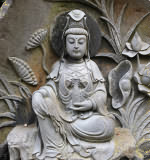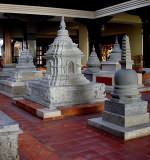Learning Sanskrit - Sacred Mantra-s: Kṣraum̐ (Kshraum)
Nrisiṁha's Bījamantra

Right-click the image and choose "Save Picture As..." or something like this to download the image
Suggestions
1) The sound Anunāsika (demilune plus dot in the original Sanskrit character above) is a nasal resonance which should be pronounced by keeping the mouth open always, feeling that the sound goes up from the palate up to the crown of the head. If you were to close your mouth at the end of its utterance, that ascension to the summit of the head would be impossible. It sounds like ng approximately.
2) Pronunciation 1 is a good document to start your pronunciation learning.
3) First of all, there is a measure unit called mātrā or the time gap needed to pronounce a short vowel (e.g. a). Short vowels (a, i, u, ṛ, ḷ) last 1 mātrā, while long vowels (ā, ī, ū, ṝ) and diphthongs (e, ai, o, au) last 2 mātrā-s. In turn, Anusvāra and Visarga last 1/2 mātrā. Anunāsika (final resonance indicated by demilune and dot in the above Sanskrit character) also lasts 1/2 mātrā and thus it should not be protracted. Granted, these measurements cannot be followed to the letter the whole time, but one should always attempt to follow them as closely as possible.
4) If you want the Mantra to have a more powerful effect on you, firstly repeat it with the physical tongue, and then with the mental tongue (i.e. repeat it in your mind). If you were to mentally repeat it once while inhaling and once while exhaling, the energy contained in that Mantra would spread much more quickly across your system.
5) Here you will find a complete explanation of the nature, characteristics, etc. of a Mantra.
6) Mental repetition of a Mantra is always more powerful that gross utterance performed by the physical tongue, as the mental tongue is subtler. However, it is usually good to start your practice with some gross utterance before entering the mental one.
7) To repeat a Mantra while one beholds its form, that is, the Sanskrit characters forming it, is extremely auspicious. Therefore, repeat the Mantra while beholding its form and then close your eyes and keep repeating it mentally.
| Transliteration | IAST (International Alphabet of Sanskrit Transliteration) |  |
| ITRANS (commonly used online) | kShrau.N | |
| HARVARD-KYOTO (also commonly used online) | kSrau.m |
The celebrated Varadātantra explains the meanings of each of the letters forming this Bījamantra in its sixth chapter:
क्ष नृसिंहो ब्रह्म रश्च ऊर्ध्वदन्तार्थकश्च औ।
दुःखहरार्थको बिन्दुर्नृसिंहं तेन पूजयेत्॥
Kṣa nṛsimho brahma raśca ūrdhvadantārthakaśca au|
Duḥkhaharārthako bindurnṛsiṁhaṁ tena pūjayet||
(The conjunct) "kṣa" (kṣa) (is) Nṛsiṁha (nṛsiṁhaḥ), and (ca) (the letter) "ra" (raḥ) (is) Brahma (brahma), and (ca) (the vowel) "au" (au) means (arthakaḥ) teeth (danta) (pointing) upward (ūrdhva). Bindu or dot (binduḥ) means (arthakaḥ) destroyer (hara) of pain (duḥkha). One should worship (pūjayet) Nṛsiṁha (nṛsiṁham) by means of that (seed-mantra) (tena)||
Commentary
- The Tantra-s (revealed scriptures, see Tantricism for more information) are presented as a dialogue between Śiva and Śakti. Pretty generally, Śiva acts as the spiritual preceptor or guru, and Śakti as his disciple or śiṣyā. Varadātantra is no exception to the rule.
- Nṛsiṁha is the celebrated Man-lion, the fourth incarnation of Lord Viṣṇu. He is generally depicted with his teeth pointing upward. He stands for protection and removal of sorrow.
- Brahma is the Absolute.
- Anunāsika (half-moon and dot) is also known as Nādabindu, being "nāda" the half-moon and "bindu" the dot. Read Meditation 6 for more information about Nādabindu, please.
- In this seed-mantra, "nāda" (the half-moon in Anunāsika) does not seem to have any special connotation, as only bindu (the dot above nāda) has been described.
- The sound "kṣa" is not really a letter, although it is very often referred to as such, but a conjunct consisting of the letters "ka" and "sa".
- Even though you can see that the sounds forming the seed-mantra are: "kṣ", "r", "au" and Anunāsika (half-moon and dot), the consonants in the Sanskrit alphabet have an appended "a". What is the reason? Because "a" is Śiva, the Supreme Self, and without Him all consonants are barren, as it were, that is, they have no power at all. Thus, Śiva describes the original consonants including "a" in the stanza, i.e. "kṣa" (even though is usually described as a letter, it is a conjunct composed of "ka" and "sa", technically speaking) and "ra" despite they appear without "a" in the seed-mantra itself.
- Bīja-s or seed-mantra-s are always monosyllabic.
| Back to Krīm̐ | Continue to read Om̐ |





























